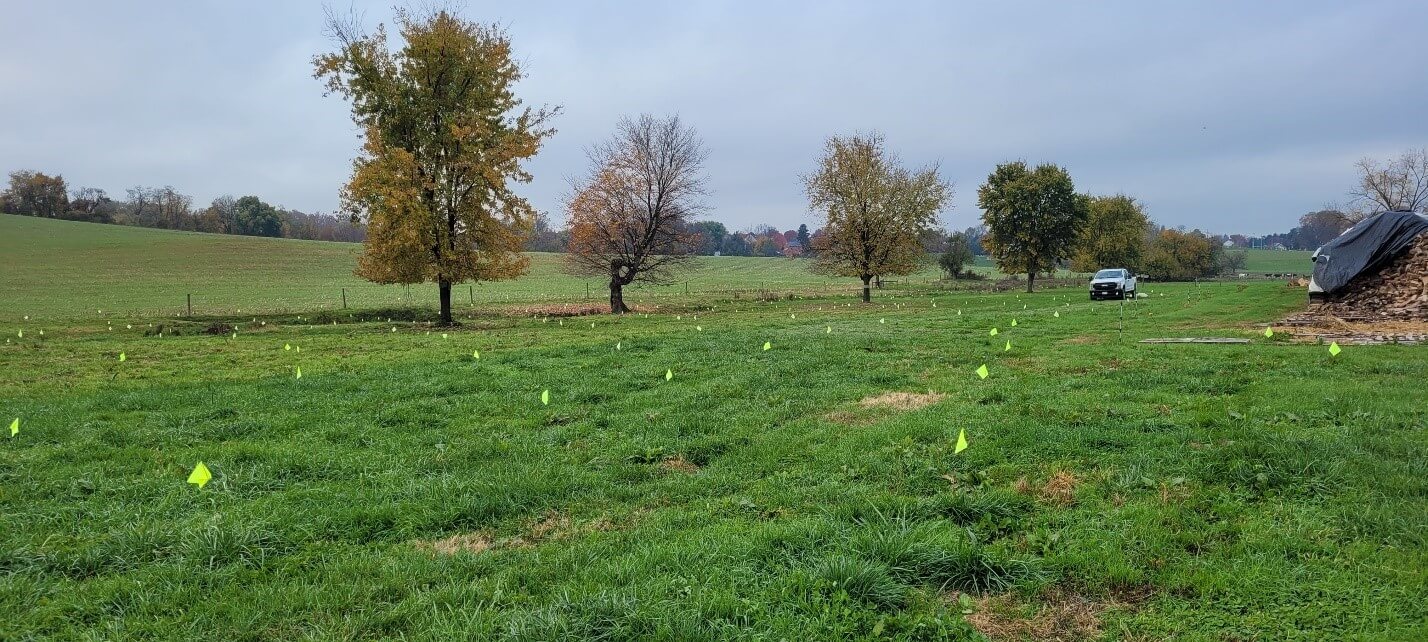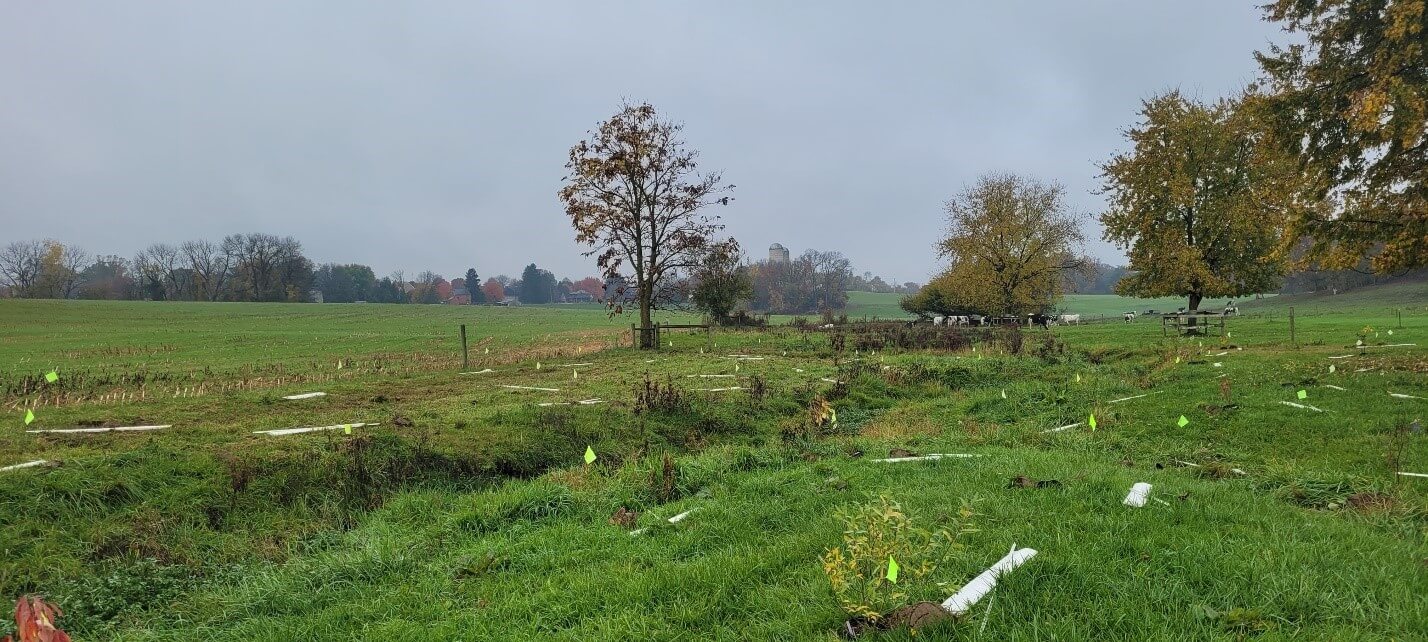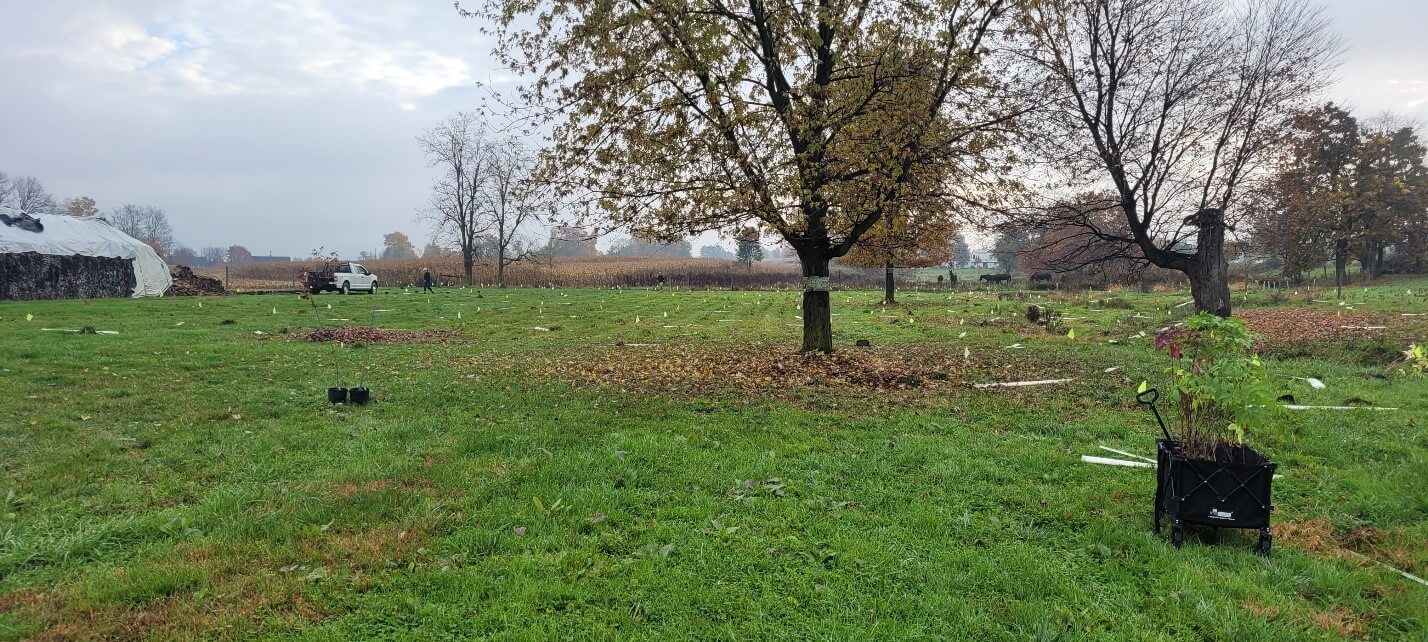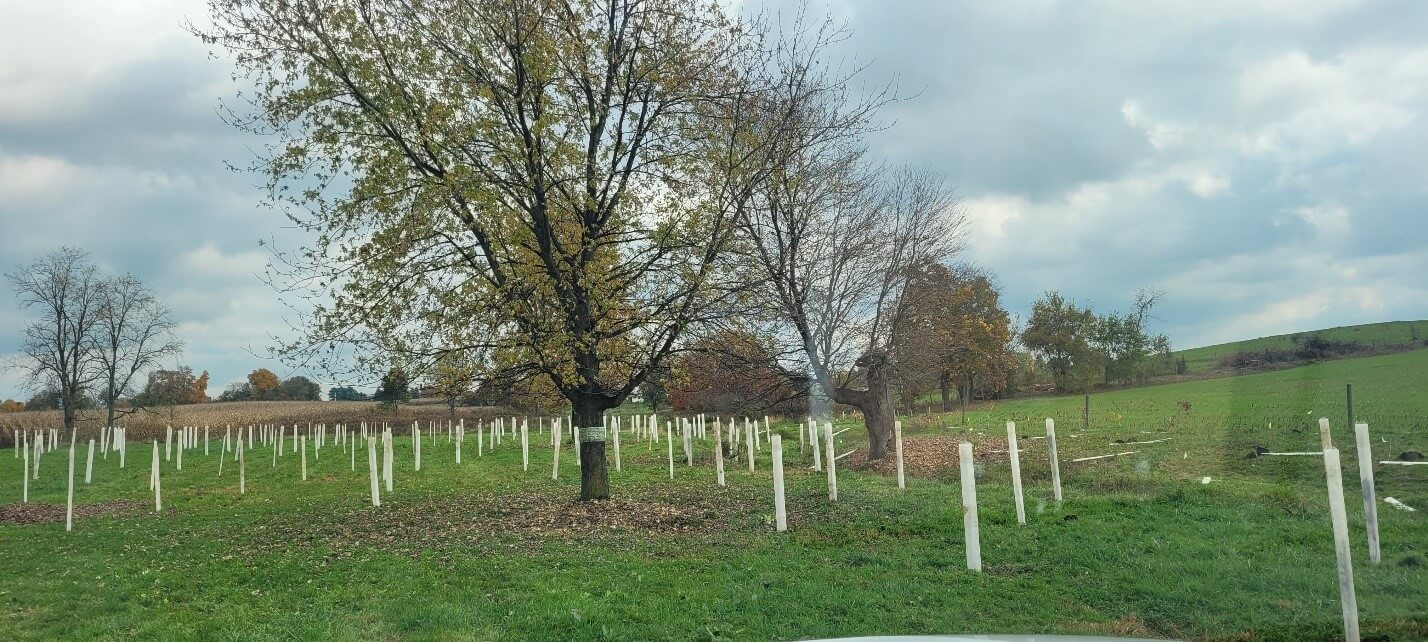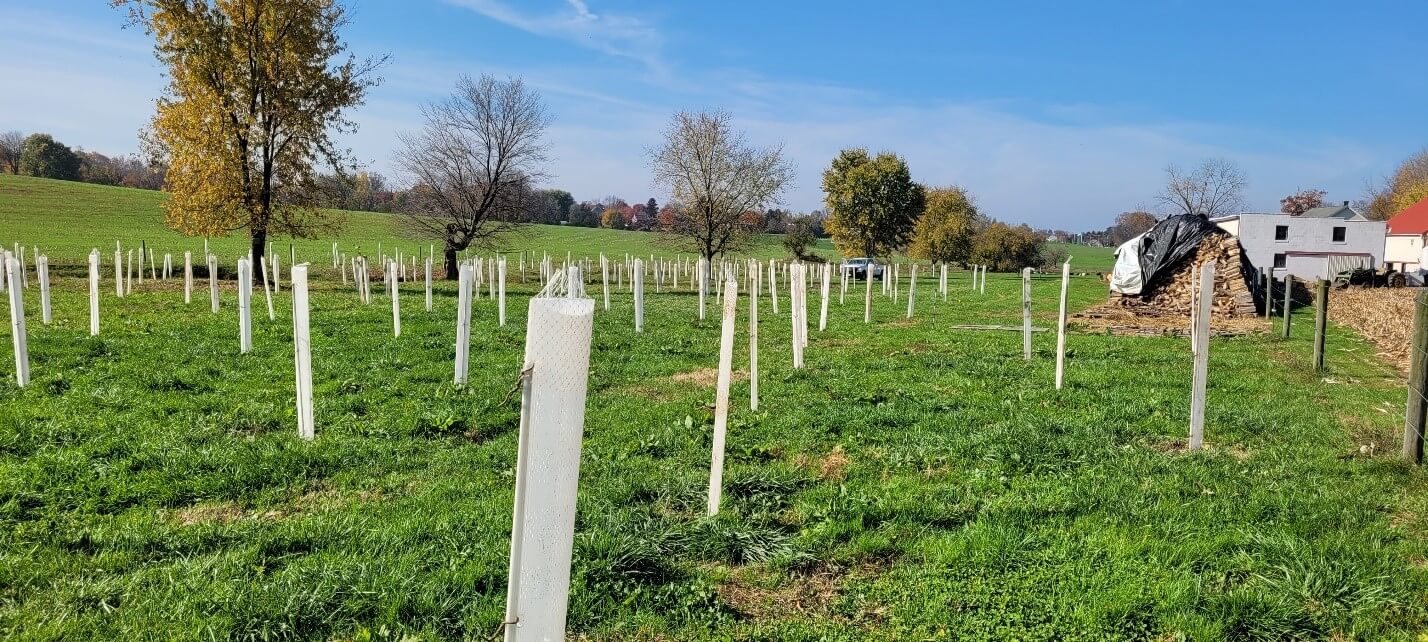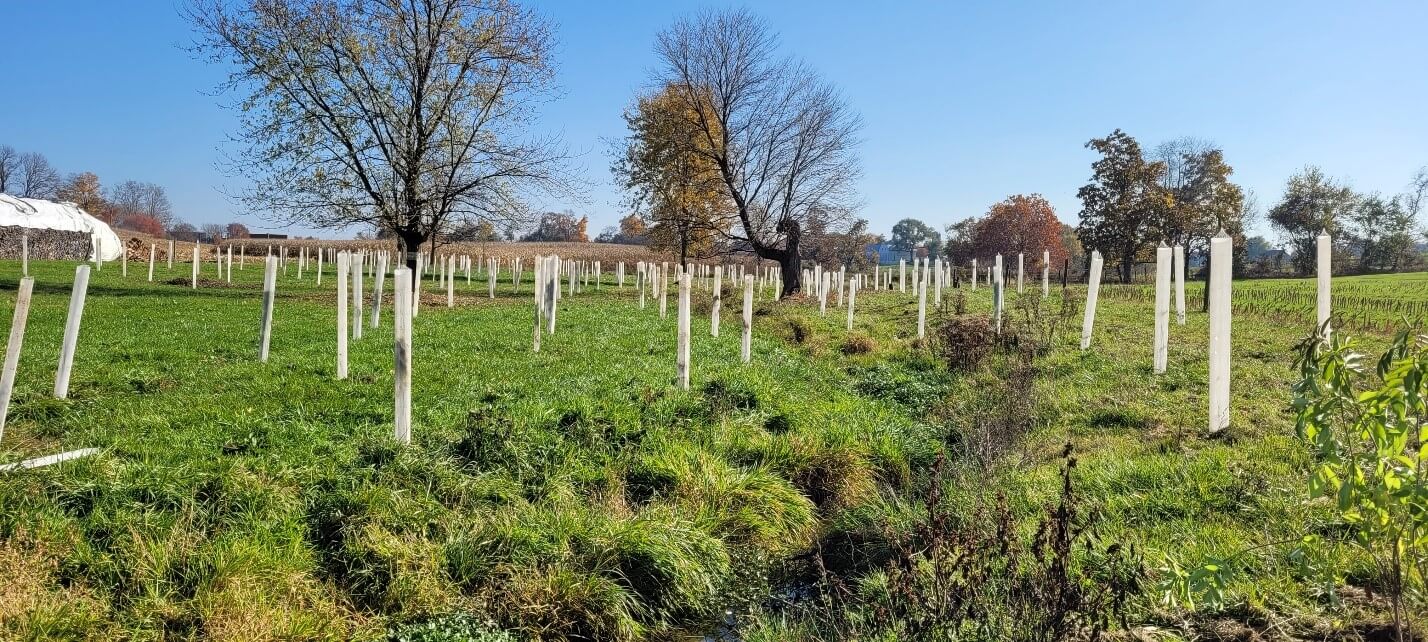Planting Diverse Riparian Buffers
A look into how LCCD designs functioning riparian buffers
Written by Tyler Keefer, Fall 2023
Introduction
As you travel around Lancaster County, you’ve likely seen fields filled with hundreds of green or white tubes, and depending on how long they’ve been there, you may even see trees sticking out of those tubes. What you’ve seen is reforestation, or tree planting, which uses tubes and stakes to protect and enhance the growth of young trees. If that reforestation is in the area next to a stream, the ‘riparian’ area, it is considered a ‘riparian buffer’. Organizations like the Lancaster County Conservation District (LCCD), Penn State, Agriculture and Environment Center, Chesapeake Bay Foundation, Alliance for the Chesapeake Bay, Trout Unlimited, and many others have used reforestation as a tool to address environmental issues in our county and beyond, all the way downstream to the Chesapeake Bay and the Atlantic Ocean. Reforestation can be tricky, but there are ways to ensure the trees survive to become established and self-managed. Tree quality, planting techniques, post-planting care, and maintenance can all increase the chances of success. However, the most important decision is made long before a shovel ever hits dirt – species diversity. Read on to find out why tree selection is so critical to reforestation efforts, and how LCCD ensures the highest chance of long-term success with species selection.

What is Diversity?
Before we discuss why diversity is important, we should first explain what we mean by diversity. In short, diversity in reforestation is the use of many different tree species when completing a project. Diversity should mean more than just ‘different species’ however, as some trees may be different species but perform the same ecosystem services and have similar pest or disease issues. Ecosystem services are processes that happen naturally that benefit humans, such as regulation of air quality, provisioning of food, nutrient cycling, and recreation. Some of the factors that are important for true diversity are:
Having fast-growing species, like tulip poplar, can get shade on the ground quickly and keep weeds away, while having slow growing species like certain oaks ensures hardy and long-lasting shade for decades to come.
Having a tree canopy that’s all one height doesn’t allow for all wildlife to use the forest you’ve planted. Some birds prefer to inhabit low growing shrubs that stay under 10 feet, while others desire the 60-80 foot trees. Variation is key!
Humans like to use reforested areas as well, so if we can plant trees that offer fruit like persimmon or plum, we’re happy to do so. When people enjoy their buffers, they’re more likely to care about its success, and to advocate for more buffers in the future.
Some trees grow tall and narrow, while others grow short and wide. The shade each one offers is vastly different, and therefor provides different benefits to the buffer. For example, trees that provide a lot of shade are excellent for weed control and keeping temperatures low during the heat of the summer. Trees that don’t provide as much shade allow sunlight to penetrate to the ground, which allows low growing plants and grasses to thrive.
Some trees have deep-traveling tap roots, while others have roots that grow outwards instead of down. All roots help to hold soil in place, so having a wide selection ensure as much coverage as possible.
Evergreen vs Deciduous, bloom time, seasonal color, pollinator value, seed value for animals, life span, insect value, drought/wet/salt/pollution tolerance, and certainly more which all play an important role in defining diversity
Why Plant Diverse Buffers?
The first, and potentially most important, reason to plant high diversity riparian buffers is for the highest chance of a successful planting. The definition of a successful planting is subjective, but for our purposes a successful planting has 75% or more of the plants survive the first 5 years. Researchers have found that planting monocultures, or plantings with only one species, results in either all of the plants succeeding, or all of the plants failing with no in-between; a forest of tulip poplar or sycamore may have 95% survivability, or only 20%. This is mainly due to the fact that if a pest or disease enters the area, all of the trees will have the same resistance or vulnerability to it. One bad year of pests can destroy an entire population. On the contrary, if an area is planted with 10 or 20 species, it’s much less likely that a single pest will affect more than a small percentage of the trees.
“One bad year of pests can destroy an entire population.”
A second, and equally important reason for high diversity plantings are the ecosystem services and value. Different trees are used by humans and wildlife alike for different reasons, so having a wide variety of trees will cater to the most organisms. For example, squirrels prefer nut-bearing species like oaks, hickory, walnut and maple. Deer also appreciate pines, spruces, and honey locusts as additional food sources. Birds use a wide variety of plants for habitat; some thrive in low growing shrubs like redbud, dogwood and birch, while others prefer tall trees like beech and oak. Some live in the same tree as other bird species, but at different heights. Evergreens are a great example of trees that provide habitat for different bird species, because coverage exists at all heights on the tree. Let’s not forget insects! Pollinators appreciate redbud, tulip poplar, willows, dogwoods, and many more. These trees provide a food source for insects, but also habitat. Many insects are highly specialized, meaning they only use one type of plant, so a wide variety of trees caters to a wide variety of insects. This is important because a robust insect population forms the base of a healthy food chain! Some researchers, like Doug Tallamy, argue that if your plantings are insect-minded, you’ll naturally cater to everything else as well.

Property Highlights
To prove that we don’t just talk-the-talk here at the Conservation District, lets highlight a project that was planted in Fall of 2022. This property is within the Mill Creek watershed, and, like many properties in Lancaster County, is surrounded by farmland and has a small stream running the entire length. Generally, when approaching a project like this, the Conservation District asks for 35’ of space on either side of the stream to plant trees, as that is the minimum space to get the benefits of a riparian buffer. We were lucky enough to receive 35’ for half of the property, and nearly 150’ for the other half, creating a project shaped like a saucepan. The landowner requested that half of the property be planted with low-growing species as to not impede their view out of their house, but LCCD was given full permission to plant the rest however we’d like. Getting an area this large and full range of plants to choose is very rare, so we wanted to take full advantage of this opportunity. About 325 trees were planted with help from volunteers from nearby schools, with 25 different species total. After planting, exclusionary fencing was added to keep cattle out of the stream and away from the trees. As for species selection, the full list is below, but some highlights are red maple, river birch, silky dogwood, winterberry, American beech, sweetgum, tulip poplar, sycamore, red oak, elderberry, fragrant sumac, and arrowwood. That’s just the original planting too, additional species are added each year during replants

The design for this project showing where only low growing species would be planted.
Planning Considerations
There are many factors that go into species selection when planning a project, but often the largest limitation is the type of space, and the size of the property. Generally, the most efficient way to purchase trees requires a minimum of 25 plants per species, so a property with only 100 trees will have at maximum 4 species. That doesn’t mean the project can’t be a success, however. In a study done by the Smithsonian Environmental Research Center (SERC) and The Nature Conservancy, having 4 species is enough to see significant benefits over just 1 species. LCCD is lucky to have a project like this one and many others, with land owners willing to allow this sort of work on their property. With 25 species and over 300 trees planted, we can expect to see a diverse insect population, variance in canopy height, habitat for a number of wild animals like deer, birds, foxes, and squirrels, and someday a healthy riparian forest area.
Below are the tree species planted in this riparian buffer:
Red Maple |
Sugar Maple |
River Birch |
Hackberry |
Redbud |
Silky Dogwood |
Red-osier Dogwood |
American Beech |
Winterberry |
Spicebush |
Sweetgum |
Tulip Poplar |
Northern Bayberry |
Black Chokeberry |
Red Chokeberry |
Sycamore |
White Oak |
Pin Oak |
Red Oak |
Black oak |
Fragrant Sumac |
Pussy Willow |
Black Willow |
Elderberry |
Arrowwood |

